
Prologue
A Winning Formula for Publishers
Running a publisher site is a lot like conducting a never-ending science experiment.
Whether it’s user behavior, load times, RPMs, web page responsiveness, or countless other variables, any one element can determine the success or squandering of that most precious resource: genuine attention time from engaged users.
Of all the opportunities on the table for publishers, video remains the most promising specimen in the laboratory. In the age of YouTube and TikTok, video enthralls text-weary visitors, sends engagement time skyrocketing, and strengthens the loyalty of even your regular audience. But, getting video right is also notoriously difficult. No one wants to deflect flyby visitors with intrusive ads, or bog down load times with heavy players.
How can publishers maximize the viewability and revenue generated by their video players, while ensuring a high-quality user experience?
In this guide, we’ll look at the science behind online video engagement, helping publishers assess the performance of their program across three key dimensions—technology, content, and UX—so you can optimize for your audience.
As brands and agencies demand greater transparency from supply-side partners, viewability has become table stakes for any video campaign. Finding the right technology partners can help you deliver a premium, contextually relevant experience, earning trust from advertisers and consumers alike.
That trust is the essential catalyst which sets everything else in motion, leading to higher viewability, increased dwell times, and more dollars from brand advertisers.
Increasing video ad viewability from 50% to 87% can result in over 80% revenue uplift across desktop and mobile.1
The booming demand for short-form video
While the buzz around online video ebbs and flows, the overarching trend is clear. Audiences are obsessed with video, and they continue to watch more hours across mobile and desktop screens each day. Savvy media owners of all sizes and verticals are positioning themselves to capture the windfall.
Consumers can’t get enough video
- Bigger than TV: One-third of time spent online is with video content2
- A daily habit: 75% of US adults watch up to 2 hours of short-form video daily3
- Built-in virality: Video content is shared 12x more than text or images4
Advertisers increasingly focus on premium video
- 55% of brands plan to increase video budgets 5% or more this year5
- 20% YOY growth6 in global digital video spend, approaching $120B by 20247
- 50% YOY growth in US digital video spend, with total revenues of $39.5B8
Mobile UX is the key to performance
- 104% increase in mobile web video impressions last year9
- 44% of all video impressions in EMEA, and 57% in LATAM, are delivered on the mobile web
- Roughly two-thirds of global video is played via mobile10
Bringing the Power of Contextual Video to Publisher Sites
Average dwell time with EX.CO video player units = 3 minutes
Key challenges that hold back publishers
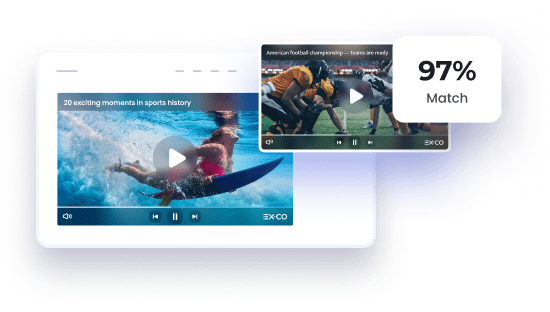
Limited production budgets
Syndication libraries and demand-side platforms (DSPs) can match existing text content with relevant videos, without the need to hire a production crew.
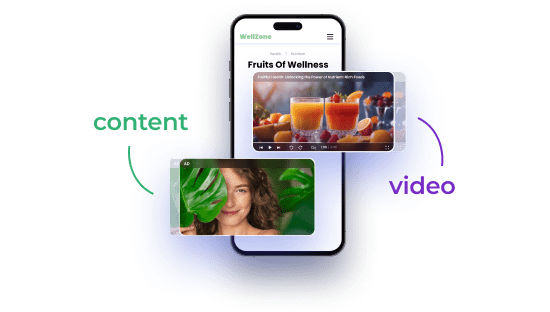
Conflicting UX philosophies
Audience-led technology partners can build video experiences that marry the interests of revenue leaders with ad-weary editorial or product teams.

Buyer concerns over valid impressions
Sticky video players help publishers deliver a seamless, in-view experience across all devices, platforms, and content types.

Inconsistent data bandwidths
Lightweight players ensure that pages load quickly on standard mobile signals, not just broadband Wi-Fi or 5G networks.
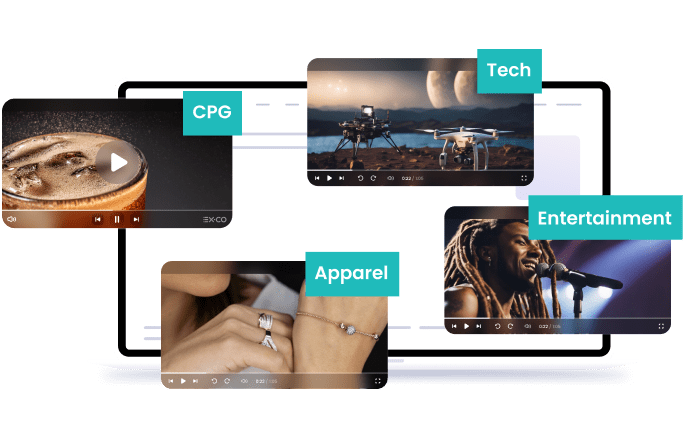
Increasing audience expectations
Publishers with robust first-party data can segment their audience and deliver different content to specific users.
What is video “viewability” and why does it matter?
It wasn’t long ago that viewability was the hottest new controversy in the world of online media. Several years ago, a flurry of reports first focused the industry’s attention around an alarming figure: more than half of digital ad impressions (including video) were unviewable.11
This revelation spawned a cautionary tale: the ghostly video ad that plays into the void, hidden either below the fold or behind layers of pop-ups and other view-jacking tactics. Such phantoms cost advertisers billions of dollars in waste each year.
After cracking down on fake clicks and traffic bots, the industry has since moved aggressively to ensure better viewability standards for videos. If there’s a hint of poor quality, or any suspicion of foul play, publishers risk not only losing out on higher CPMs, but seeing entire revenue pipelines go dry.

“Like most publishers, the focus on viewability has been at the forefront of nearly every strategy decision we have made in recent years. Brands need to know that their ads are being seen, as a non-viewable ad will naturally struggle across other performance metrics, and poor results not only negatively affect the advertiser, but they also ultimately hurt the pockets of the publisher by driving down yields.
Our 70%+ viewability results allow us to have robust and effective conversations with brands and agencies, as not hitting the viewability benchmark instantly builds a hurdle that has previously stopped a sales pitch in its tracks. Last month, 54% of our overall revenue was driven by onsite video. Simply put, without us hitting the required 70% benchmark, we would lose the deals driving that stream of income.
We also use our viewability metrics (alongside dwell time) to better inform the editorial team of wins across highly engaging editorial content. I believe that by ensuring we are hitting viewability benchmarks, it makes us as a publisher strive to do our best for our advertisers.”
Agencies and advertisers in a race to the top
While there’s no single definition of viewability, arguably the most commonly cited standard is the one released jointly by the Interactive Advertising Bureau (IAB) and Media Ratings Council (MRC), which defines the term as follows: At least 50% of a video ad’s pixels must appear on-screen for at least 2 consecutive seconds.12
That might sound like a low bar, but it’s still far from reality. Average viewability rates can range from 50-90% across various online ad formats, raising significant concerns and advantages to be won or lost, depending on the quality of one’s supply chain.
Today, media agencies and DSPs compete on the premium quality of their supply partners’ video inventory. Some strive for 100% in-view ads, while others look for at least 50% completion of a native or outstream ad.
Looking ahead, the only guarantee is that these definitions will continue to evolve. Publishers can stay one step ahead by always using engagement and UX as a north star, which by transitive property, will all but ensure strong viewability regardless of criteria.

“Advertisers want every chance to succeed. So, partners have to meet minimum viewability requirements; that’s your general admission ticket to be considered. But the minimum won’t equate to real success. Maximizing viewability is how you navigate your way into VIP (very important partner) status.”
Busting the biggest myths in viewability
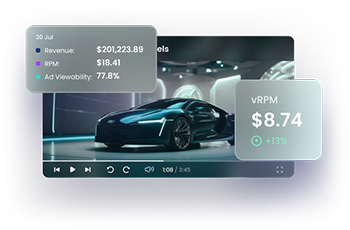
vRPM is the future
When technology or demand-side partners tout a theoretically higher “viewable RPM,” ask to see the math, which is almost certainly pseudoscience, obscuring the sunk cost of non-viewable impressions.
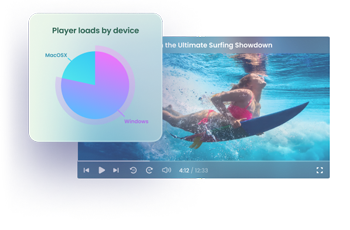
One metric fits all
There will always be debate over how best to measure viewability, so publishers should be conscious of their partners’ evolving definitions, including those held by 3rd-party verification tools such as Moat, DoubleVerify, or Integral Ad Science.
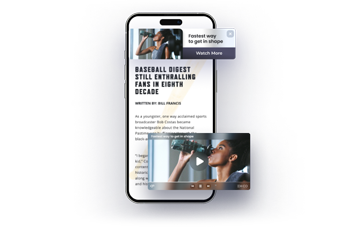
Sticky players are bad
When built with UX in mind, sticky players not only work—they repeatedly win outsized engagement, as seen in the success of videos delivered via YouTube, Facebook, and EX.CO.

Not everyone can monetize video
Even publishers with zero existing video content can engage and monetize audiences with turnkey libraries and player technology.

“An ad should have the opportunity to be seen, so its placement should be as such. People across our industry scrutinize reporting and get fixated on a percentage, but sometimes they should just look at a property where they’re advertising and make sure that those ads have an actual opportunity to be seen in a way that’s respectful to users.”
Think of outdoor advertising. You don’t really question whether or not an OOH ad will be seen because it’s usually situated in a prominent place that’s designated for advertising, whether it’s a good fit there or not. Digital should really have followed suit, and it might have done so if there wasn’t so much scrutiny around percentages.”
Beyond viewability
What’s the connection between chemistry and online video? Whenever there are countless variables in play, it helps to break things down into their constituent parts. By looking at each building block, you can learn how to best combine each element and capitalize on its unique characteristics. The pathway to success is to test, iterate, retest, optimize, repeat. To bring this philosophy to life, we created a “periodic table” of video engagement that arranges our atomic elements into three broad groups: Content, Technology, and UX.
All three dimensions are required to deliver impactful video experiences. And, any one element can make or break your formula, if not calibrated appropriately for your particular audience and publication.
The periodic table of video engagement |
15AtAttention
|
18MfMobile-first
|
|||||
|
1DsDemand sources
|
Tap an element to discover more…
15
At
Attention
Attention
The currency of online media that measures engagement beyond just viewability, denoting scarce, high-intent audiences that garner premium CPMs. 20
Nu
Native units
Native units
Seamless video players that appear fully integrated into existing content and match a site’s look and feel. 19
Ca
Carousel
Carousel
Players with built-in navigation turn single video impressions into binge viewing experiences. 16
Ps
Player size
Player size
Larger players automatically increase viewability, leading to 15-20% higher CPMs on average. 18
Mf
Mobile-first
Mobile-first
Content that is optimized for mobile environments, thereby drawing a more engaged audience. 17
Pp
Player placement
Player placement
Above the fold videos almost always generate higher engagement (but it’s still worth testing everywhere). 21
Sp
Sticky players
Sticky players
Customizable, responsive players keep videos present as users scroll, boosting RPMs by 20%. 3
Cq
Content quality
Content quality
High-quality video helps publishers differentiate from competitor sites, enabling them to attract more premium advertisers and active readers. 2
Cx
Contextual
Contextual
Situational cues help deliver relevant ads and content recommendations, increasing CTRs and time on site. 5
Pl
Playlists
Playlists
Custom video feeds around a trending or evergreen topic encourage binge viewing and significantly boost dwell time. 6
Sy
Syndication
Syndication
Third-party libraries include thousands of pre-made, vertical-specific playlists in multiple languages, updated weekly. 1
Ds
Demand sources
Demand sources
Video inventory can draw from a mix of organic content, sponsored ads, and dynamic media that turn articles or galleries into snackable clips. 4
Re
Recirculation
Recirculation
Recirculating organic videos, articles, or galleries lowers bounce rates, increases time per visit, and strengthens brand loyalty. 7
Rs
RSS
RSS
Turn your latest hits into a beautiful video feed to promote your top content and give your audience a reason to stay on-site longer. 9
Ar
Algorithmic recommendations
Algorithmic recommendations
AI-driven recommendations can surface videos that viewers might want to see next based on viewing patterns or popular videos. 13
Cp
Click-to-play
Click-to-play
User-initiated players indicate high intent and ensure 100% viewability, but might also lower impression volumes. 14
Au
Autoplay
Autoplay
Keep these players in-view and muted to start; that way you’ll grow impressions while maintaining a good UX. 11
Lt
Load times
Load times
If your website is fast, that means more ads can load faster, too, which will inevitably increase your impressions delivered and average viewability rates. 8
Pz
Personalization
Personalization
Leverage audience segmentation to deliver the most relevant videos that are personalized for your target audience. 10
Ve
Verification
Verification
Smooth ad-ops integrations with tools like Google TrueView ensure you’ll get recognition for the user attention you deliver. 12
Wa
Website analytics
Website analytics
Analytics tools measure your overall traffic and trendlines, while heatmaps reveal high-impact placements to engage users with video. |
16PsPlayer size
|
19CaCarousel
|
||||
|
2CxContextual
|
4ReRecirculation
|
6SySyndication
|
8PzPersonalization
|
10VeVerification
|
12WaWebsite analytics
|
17PpPlayer placement
|
20NuNative units
|
|
3CqContent quality
|
5PlPlaylists
|
7RsRSS
|
9ArAlgorithmic recommendations
|
11LtLoad times
|
13CpClick-to-play
|
14AuAutoplay
|
21SpSticky players
|
ContentComprises the substance of your video programming, its relevance to your audience, and methods of editorial or sponsored curation. |
TechnologyDescribes the technical factors that accelerate or impede the delivery of your video experience, as well as measurement and optimization. |
UXEncompasses all aspects of how users engage with your player, including placement, size, design, and responsiveness. |
The periodic table of video engagement

Rotate your device to see the table

“Viewability is a top priority for both agencies and clients. It is vital to be sure we are reaching not only the right audience, but an audience that is present and engaged.”
21 elements that can lift viewability, boost RPMs, and catalyze your video program
Like any clever chemist, innovative publishers constantly experiment with a variety of tools and techniques to spark improved outcomes. Gathered below is a shortlist of key elements that have generated the highest level of impact across EX.CO’s hundreds of publisher partners, often generating results of up to 40% higher RPMs and 3x dwell times, sometimes in a matter of weeks.
Dynamic video that cuts through the noise
EX.CO’s lightweight, highly viewable video players maximize engagement and minimize distractions, across all devices and browser sizes.

Top
Earn up to 20% higher RPMs with this responsive video player that’s proven to boost viewability and enhance the UX for more positive audience interactions. You can also add an optional subscribe CTA.
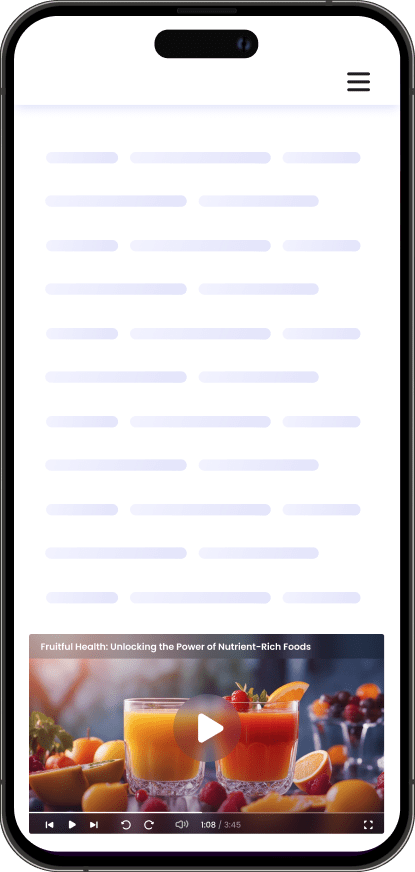
Bottom
Engage your audience with video content and ads while lowering negative audience interactions and improving viewability.

Bipositional
Keep your user engaged with videos that float across the page and move with the reader.
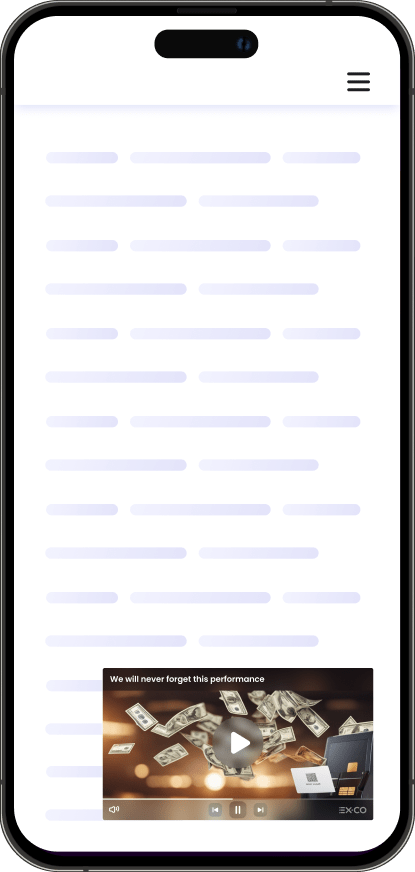
AMP
Transform underperforming AMP pages into incremental revenue powerhouses with a viewable video player that offers better engagement with content and a materially higher RPM.
How to deliver video that is right for your site
There’s no one-size-fits-all approach to video. While audiences on VICE.com may be inclined to watch longer feature videos, visitors to a local news site like SFGate may be more inclined towards a series of clips about the week’s major headlines.
Publishers must take stock of their unique editorial brand and audience before deciding which video strategy is right for them. Whatever route you take, you’re working towards a common goal—creating environments conducive to people spending time with the player.
Know your architecture
- Start with an audit of your current website layout and taxonomy, assessing all opportunities for where and how to launch or optimize video players.
- If you have primarily text-based articles, supplement these experiences with videos that promote related content from syndicated publisher feeds or sponsored brand libraries.
- For digital-first publishers with lots of galleries or infinite-scroll experiences, promote a targeted, high-impact video through responsive players that adapt to the evolving page UX.
Know your audience
- Continuously analyze your audience’s behavior to understand where people are spending time on your site, what types of content they’re consuming, and how they navigate between pages and sections.
- Look beyond Google Analytics to heatmap tools like Hotjar or FullStory to see where users focus their attention on each page, how much of an article or gallery they’re consuming before bouncing, and which calls-to-action (CTAs) are actually working.
- Fine-tune your overall inventory by amplifying popular video categories (e.g. games, entertainment, or shopping) and dialing back your video footprint.
What to look for in a video technology partner
There’s certainly no shortage of vendors in the marketing technology space today. But, it can be challenging to find a solution that fits not only your current requirements, but will grow and adapt alongside your business as a true partner.
Investing the necessary time up-front in the selection process will pay enormous dividends when it comes to executing and proving the value of your video program. Here are a few things to look for.
-
Deep expertise in content — not just in ad tech
If a technology solution has been successfully leveraged by editorial and audience development teams, chances are it’s well-suited to deliver premium video ad experiences as well.
Technical support for a variety of video formats.
Flexibility is key in the age of digital, and you’ll need a partner that supports a range of player formats including in-stream, footer, header, sticky, carousel, and more.
-
Advanced capabilities in contextual targeting
The death of cookies means that publishers need to work with technology partners that can place ads based on context, inferring audience interest based on situational cues.
-
Lightweight players that load quickly, everywhere
Evaluate each player type with rigorous technical Q/A tests to ensure they are optimized for speed and responsiveness.
-
Robust syndication libraries
No matter how large or small your owned video library, syndicated videos can enhance your static article or gallery pages with contextually relevant content.
-
Free trials for multiple team members
The only way to gain full confidence in a partner is to take their solution for a test drive, and make it easy for colleagues to join as well.

“Look for a true partner who will dedicate product resources to your relationship, a partner that will look at your site holistically and work with different stakeholders to ensure the solution meets and fulfills everybody’s KPIs. For example, user experience is important when activating a floating player so ask for customization and branding to ensure it looks native and seamless. This experience will help boost viewability and therefore ad revenue for both your demand stack and your partners while also driving engagement without sacrificing the UX.”
Get started today
and boost your viewability
within days.
Secure your future with a video technology partner that prioritizes premium content and viewable players. This will keep your publication competitive when it comes to attracting brand dollars and agency budgets; it will also equip your editorial teams with the necessary tools for keeping audiences engaged and combing back for more.
Discover why over 500 leading publishers — including Hearst, CBSi, Refinery29, VICE, and more — choose EX.CO to enhance their websites and grow faster through engaging video.

“EX.CO has always been an ally for HuffPost. Their technology has been vital in increasing our readers’ engagement with our content, allowing us to offer our best content in a more enjoyable way for our readers and without the need to add complicated processes to our workflow. The fact these units contain a monetizable element and therefore a potential stable source of income makes it even better.”
Sources
- Think with Google, “Ad Viewability: Revenue Uplift Statistics”, 2019
- Enterprise Apps Today, “Video Marketing Statistics”, March 2022
- eMarketer, “Insider Intelligence: Digital Video”, April 2022
- Enterprise Apps Today
- Wistia, “2022 State vof Video Report”
- CNBC, “Digital Ad Spend Grows Despite Pandemic”, April 2021
- Statista, “Worldwide Online Video Advertising Spending, 2020 to 2024”
- IAB, “Digital Advertising Soared 35% to $189 Billion in 2021”
- DoubleVerify, “2021 Global Insights Report”
- Yans Media, “Mobile Video Statistics”, 2020
- New York Times, “The Great Unwatched” May 2014 and “AdAge, 56% of Digital Ads Served Are Never Seen, Says Google”, December 2014
- AdPushUp, “A Primer on IAB and MRC Ad Viewability Standards”, Sept. 2020
Get in touch
Please leave your details and a specialist from our team will reach out.